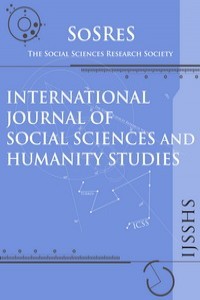ALLOCATION OF PARENTS’ TIME TO CHILD CARE AMONG TURKISH FAMILIES: EVIDENCE FROM TIME-USE SURVEY
ALLOCATION OF PARENTS’ TIME TO CHILD CARE AMONG TURKISH FAMILIES: EVIDENCE FROM TIME-USE SURVEY
Time use, child care Turkey,
___
- Baker, Michael and Kevin Milligan (2013). “Boy-Girl Differences in Parental Time Investments: Evidence from Three Countries”, NBER Working Papers 18893. Cambridge, Mass.: NBER.
- Barcellos, Silvia H., Leandro Carvalho and Adriana Lleras-Muney (2012). Child Gender and Parental Investments in India: Are Boys and Girls Treated Differently?” NBER Working Paper 1778. Cambridge, Mass.: NBER.
- Büchel, Felix and Greg J. Duncan (1998). “Do Parents’ Social Activities Promote Children’s School Attainments? Evidence from the German Socioeconomic Panel”, Journal of Marriage and the Family, Vol. 60, No. 1, pp.95-108.
- Datcher-Loury, Linda. (1988). “Effects of Mother’s Home Time on Children’s Schooling”, The Review of Economics and Statistics, Vol.70, No. 3, pp.367-373.
- Foster, Gigi and Kalenkoski, Charlene,M. (2010). “Tobit or OLS? An Empirical Evaluation under Different Diary Window Lengths”, The University of South Wales Australian School of Business School of Economics Discussion Paper 1. Sydney. Australia.
- Guitérrez-Domenèch, Maria (2010). “Parental Employment and Time with Children in Spain”, Review of Economics of the Household, Vol. 8, No. 3, pp.371- 391.
- Guryan, Jonathan, Erik Hurst and Melissa Schetini Kearney (2008). “Parental Education and Parental Time with Children”, Journal of Economic Perspectives, Vol. 22, No. 3, pp.23-46. Hallberg, Daniel and Anders Klevmarken (2003). “Time for Children: A Study of Parent’s Time Allocation”, Journal of Population Economics, Vol.16, No. 2, pp.205-226.
- Kalenkoski, Charlene M., David C. Ribar and Leslie S. Stratton (2009). ”The Influence of Wages on Parents’ Allocations of Time to Child Care and Market Work in the United Kingdom”, Journal of Population Economics, Vol.22, No.2, pp.399-419.
- Kalenkoski, Charlene M. And Gigi Foster (2008). “The Quality of Time Spent with Children in Australian Households”, Review of Economics of the Household, Vol.6, No.3, pp.243-266. Kimmel, J. and Connelly, R. (2007). Mothers’ Time Choices: Caregiving, Leisure, Home Production and Paid-work. Journal of Human Resources, Vol. 42, No.3, pp.643-661.
- Sayer, Lianna C., Anne H. Gauthier and Frank F. Furstenberg, Jr. (2004). “Educational Differences in Parents’ Time with Children: Cross-national Variations”, Journal of Marriage and the Family, Vol.66, No.5, pp.1152-1169.
- Sayer, Lianna C., Suzanne M. Bianchi and John P. Robinson (2009). “Are Parents Investing Less in Children? Trends in Mothers’ and Fathers’ Time with Children”, American Journal of Sociology, Vol.110, No.1, pp.1-43.
- Başlangıç: 2009
- Yayıncı: Sosyal Bilimler Araştırmaları Derneği
COOPERATION AND TRUST IN THE CONTEXT OF DECENTRALIZATION REFORMS IN RURAL TANZANIA
Zacharia S. MASANYİWA, Anke NİEHOF, Catrien J. M. A. TERMEE
EFFECTS OF PRESENTEEISM SYNDROME ON EMPLOYEES’ BURNOUT LEVELS
M. Halit YILDIRIM, Muhammet SAYGIN, Şerife UĞUZ
Muhammet SAYGIN, M. Halit YILDIRIM
ASSOCIATION OF HAPPINESS AND SOCIO-ECONOMIC VARIABLES IN A SOUTH AFRICAN TOWNSHIP
Tshediso Joseph SEKHU, Paul-françois MUZİNDUTSİ
CORRELATES OF POVERTY AMONGST HOUSEHOLDS RECEIVING GOVERNMENT GRANTS IN A SOUTH AFRICAN TOWNSHIP
Mmapula Brendah SEKATANE, Tshediso Joseph SEKHU
A CREATIVE CLUSTER: BABIALI - ISTANBUL
Pınar HANSOY, Nuran Zeren GÜLERSOY
THE GEZİ PARK PROTESTS AND YOUTH IN TURKEY: PERCEPTION OF HÜRRİYET COLUMNISTS
DETERMINANTS OF WELLBEING IN A SOUTH AFRICAN TOWNSHIP
Paul-françois MUZİNDUTSİ, Tshediso Joseph SEKHU
TIME SERIES ANALYSIS ON STOCK MARKET FOR TEXT MINING CORRELATION OF ECONOMY NEWS
Sadi Evren SEKER, Cihan MERT, Khaled AL-NAAMİ, Nuri OZALP, Ugur AYAN
